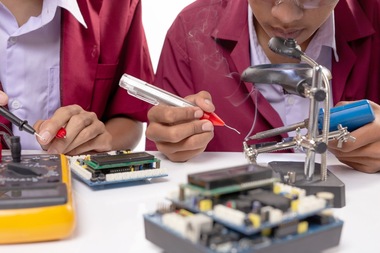☰ Menu
Menu

Soldering is a fundamental skill of advanced manufacturing. IPC training gives prospective manufacturers the knowledge they need to create safe and effective connections on printed circuit cards. If you are new to the world of PCB assembly services, then soldering training shouldn’t intimidate or overwhelm you. Join us as we break down some basic expectations to bring with you into your first IPC certification.
Tools of the Trade
For even amateur soldering manufacturers, you don’t need many tools to get started. When you enroll in certification classes, these tools will typically be provided for you, as well. These are just a few basic facets of soldering that you’ll be introduced to during your soldering training:
Soldering Material
After the soldering iron, solder itself will be one of the materials you interact with most. Solder is a metal alloy material that can be melted down to ensure better electrical contact between copper pads and electronic components. Newcomers to soldering training will be taught best practices for melting solder, as well as sanitation and ventilation during the soldering process.
Keeping Your Iron Clean
It’s important to keep soldering tips clean by removing oxidation. When tips oxidize, they will eventually turn black and their soldering quality will suffer. That being said, conventional cleaning methods like wet sponges can also compromise the lifespan of soldering tips. Soldering students will be introduced to cleaning tools that will remove oxidation without harming the tip, like brass sponges.
Soldering Safety
Soldering irons can reach temperatures of up to 800 degrees Fahrenheit in order to melt solder. This of course makes soldering dangerous without the proper exercises in caution. Fortunately, there are plenty of ways to stay safe – all of which will be taught to you during soldering training. For example, it’s important to solder in well ventilated areas, and to always wear protective eye wear.
Soldering is a valuable skill and a crucial aspect of advanced manufacturing. IPC certification classes have been refined over many years to offer the most efficient learning experience for soldering students who are both new to the industry and experienced. Check out our catalog of soldering certifications today to see which course works best for you.